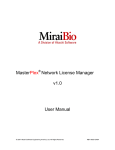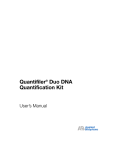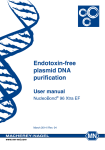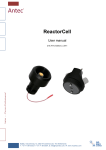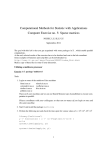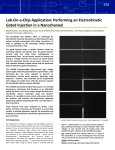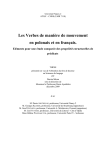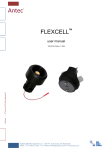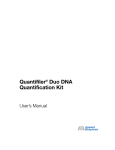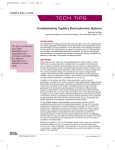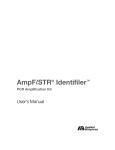Download Separation due 030711
Transcript
Amplified DNA Product Separation for Forensic Analysts This course is provided free of charge and is part of a series designed to teach about DNA and forensic DNA use and analysis. Find this course live, online at: http://dna.gov/training/separation Updated: October 8, 2008 www.DNA.gov About this Course This PDF file has been created from the free, self-paced online course “Crime Scene and DNA Basics for Forensic Analysts.” To learn more and take this and other courses online, go to http://www.dna.gov/training/online-training/. Most courses are free but you must first register at http://register.dna.gov. If you already are registered for any course on DNA.gov, you may login directly at the course URL, e.g., http://letraining.dna.gov or you can reach the courses by using the URL http://www.dna.gov/training and selecting the “link. Questions? If you have any questions about this file or any of the courses or content on DNA.gov, visit us online at http://www.dna.gov/more/contactus/. Links in this File Most courses from DNA.Gov contain animations, videos, downloadable documents and/or links to other useful Web sites. If you are using a printed, paper version of this course, you will not have access to those features. If you are viewing the course as a PDF file online, you may be able to use some of these features if you are connected to the Internet. Animations, Audio and Video. Throughout this course, there may be links to animation, audio or video files. To listen to or view these files, you need to be connected to the Internet and have the requisite plug-in applications installed on your computer. Links to other Web Sites. To listen to or view any animation, audio or video files, you need to be connected to the Internet and have the requisite plug-in applications installed on your computer. Legal Policies and Disclaimers See Legal Policies and Disclaimers for information on Links to Other Web Sites, Copyright Status and Citation and Disclaimer of Liability and Endorsement. Amplified DNA Product Separation for Forensic Analysts Overview Electrophoresis is a process for separating charged molecules based on their movement through a medium under the influence of an applied electric field. This module will introduce some of the early adaptations of electrophoresis in human identification laboratories. The next module deals with the technology used today. In 1807, Russian scientist F. F. Reuss observed the migration of particles in an electrical field establishing the foundation for the work of the Swedish chemist Arne Wilhelm Tiselius. In 1930, Tiselius introduced a method for separating proteins in suspension using electric currents, which was termed electrophoresis. He was awarded the 1948 Nobel Prize in chemistry for this work.01, 02, 03 Today, electrophoresis has many applications for separation of the components of mixtures and is the method of choice for amplified DNA product separations. Objectives Upon successful completion of this unit of instruction, the student shall be able to: • Explain the process of electrophoresis. • Identify the components for successful separation of amplified DNA products. • Compare and contrast the methods of agarose gel and polyacrylamide electrophoresis. • Describe the methods used to detect amplified DNA products separated using different types of slab-gel electrophoresis apparatus. Electrophoresis Slab gels were the first media used for the separation of amplified product in forensic DNA analysis. The basic method entails the mixing of gel materials together with a buffer and pouring it into a mold to define the gel structure. The gels may be formed in a vertical or horizontal format. The slab-gel medium is supported on a backing of glass or plastic, or sandwiched between two glass plates, and then inserted into a chamber, which is most often made of Plexiglas®. 1/22 Amplified DNA Product Separation for Forensic Analysts Gel combs are used in the molding process to form wells. The amplified DNA samples are placed in the gel wells and exposed to an electric field while submerged in a buffer solution. The amplicons migrate through the gel in lanes defined by the samples wells, in response to the field. Smaller molecules move faster and farther than the larger ones. The amplicons are visualized using a staining technique or with florescent tags, resulting in sample bands that have a bar-code pattern representing the different-sized molecules. Slab gels, once popular techniques, have largely been replaced by capillary electrophoresis methods, which are easier to use, increase resolution, and automatable. The theory of electrophoresis is the underlying basis for these methods. Slab-gel Electrophoresis Steps 1. Prepare the gel matrix 2. Pour onto support backing; allow to solidify 3. Place into apparatus 4. Add appropriate buffer 5. Load the samples and standards 6. Apply the electrical current for separation 7. Allow to separate 8. Collect data either through on-line detection or image after gel staining 9. Analyze sample data The electrophoretic separation of molecules depends on two forces: charge and mass. The DNA molecules are negatively charged and have a constant charge-to-mass ratio since the negative charges along the phosphate backbone are evenly spaced. The charges on the DNA molecules are essentially equivalent; therefore, the separation is based on mass alone. The electrical current from one electrode, the cathode, repels the molecules, while the anode simultaneously attracts them. The gel matrix acts as a molecular sieve. During the electrophoresis, the molecules are forced to move through the gel matrix, separating the amplified DNA products by size. The separation medium contains a denaturant in order that the electrophoresis is conducted on single-stranded DNA fragments. Single-stranded DNA fragments are more similar to each other than double-stranded DNA fragments are to each other. Double-stranded DNA produces more electrophoretic diversity due to its three-dimensional structure. Many factors can influence the migration and separation of amplified DNA products. These factors include both the physical and chemical environment. Alteration of the gel matrix, apparatus, and buffer can have dramatic effects on the electrophoretic system. Ohm's law: V=IR, where: • V = voltage • I = current • R = resistance Ohm's law demonstrates that an increase in voltage with a constant resistance will increase the current. 2/22 Amplified DNA Product Separation for Forensic Analysts A discussion of electrophoresis would not be complete without introducing Ohm's law. When voltage is applied to the gel by the two electrodes, the current is influenced by the resistance of the gel. When resistance is constant, then voltage and current are proportional. Increasing the current will cause an increase in the voltage. Increasing the current will increase movement of the ions through the gel, thus decreasing the time for the fragments to pass the required distance. Voltage (V) is the product of current (I) and resistance (R); therefore, V/R determines current (I). Current produces heat, which must be dissipated or it will be absorbed by the system. Excessive heat can cause the DNA sample to migrate irregularly within the sample lane, resulting in the generation of sample bands that "smile." In very severe cases, the gel can literally fall apart. Apparatus Early types of apparatus were relatively simple in design, consisting of tanks with two buffer reservoirs, one at the cathode and the other at the anode electrode. The gel is submerged in the buffer solution, thus allowing a voltage to be applied across the gel. In the above animation, the sample wells are loaded with amplified DNA products. Once the sample wells are loaded and current applied, simultaneous electrophoresis can occur for all samples. As the sample migrates through the slab gel, a sample lane is defined. With the advances in the biotechnology industry, these tanks evolved in sophistication. Some examples are buffer recirculation ports and cooling plates for the gel to sit on, both of which can effectively remove heat generated during electrophoresis. View an animation explaining slab-gel electrophoresis. Gel Matrix Two types of gels are commonly used in for amplicon separation in forensic DNA analysis: • Agarose • Polyacrylamide gel (PAG) Agarose is made from seaweed and consists of long chains of polysaccharides, which interlink to form a matrix with large pores. Agarose is non-toxic and has high gel strength. Agarose gels are generally used to separate larger DNA molecules. Polyacrylamide gels have much smaller pore sizes, are generally stronger than agarose gels, and are used to separate smaller DNA molecules. PAGs use two major monomers: monoacrylamide and a cross-linking agent, N, N' -methylene- bis -acrylamide, often referred to as bis -acrylamide. The polymerization process involves the mixing of the monomer solutions in the presence of free radical catalysts and accelerators. The PAG is formed by covalent bonding of the acrylamide and bis -acrylamide. This covalent linking produces a molecular sieving gel. Note: Monoacrylamide is a known neurotoxin and must be handled with care. Both types of gels have a texture very much like a colorless gelatin, ranging from a solid support medium to a viscous liquid. The amount of sieving can be controlled by adjusting the concentration of the gel. The main difference between polyacrylamide gels and agarose gels is that PAGs are created chemically versus the biological origin of agarose gels. For separation of amplified DNA products on slab-gels, polyacrylamide gels (PAGs) are the matrix of choice. Characteristics of PAGs: 3/22 Amplified DNA Product Separation for Forensic Analysts • Transparent in the visible and portions of the UV spectrum • Reproducible, completely chemically synthetic compared to biological agarose gels • Strength of gel and easy to handle • Non-reactive with samples since there is no charge associated with it; therefore, the DNA fragments are not subjected to electroendosmotic effects • Stable • Thin gels can be cast which can promote better separations at higher field strengths due to efficient heat dissipation • Permanent record of separation • Pore size can be manipulated to increase molecular sieving • Different buffers can be used such that resolution and run times can be manipulated • Toxic • Need to formulate gel mixture and pour the gel • Need to degas the gel mixture under a vacuum to reduce bubbles • Possibility of bubble formation, even if degassed • Wait for polymerization – time-consuming View an animation about polyacrylamide gels. Buffer System Electrophoresis requires the use of a buffer system. A buffer is a chemical system that maintains a relatively constant pH even when strong acids or bases are added. Buffer solutions contain either a weak acid or a weak base and one of their salts. Buffers not only establish a pH, but provide ions to support conductivity. During electrophoresis, the electric field electrolyses the water molecules into H+ and OH- ions that migrate to the respective migrate to the respective electrodes. The increase in H+ and OH- alters the pH at each electrode. A buffer can effectively neutralize the ions so that the pH of the system is maintained. The makeup of the buffer system is critical in the separation of the amplified DNA products by ensuring that the sample molecules are ionized and controlled. Changes to the buffer system can lead to poor separation and lack of reproducibility. Small changes in pH can change molecular charge; whereas, large changes in pH can cause serious, irreversible changes in molecular structure. Nucleic acids are relatively unaffected by pH changes due to their negative charge.04 The choice of buffer system will affect the resolution of the components in the mixture. Both continuous and discontinuous buffer systems can be used. A continuous system uses the same buffer for the tank and gel. In continuous systems, molecular charge and gel pore size are the only factors that have any effect on the separation and stacking or concentration of a sample into a band. A concentrated band of sample forms where the molecules are slowed down at the interface of the buffer and the gel. Since smaller molecules have less of a difference between their free solution mobility and their mobility in a gel, the stacking of smaller fragments is not as favorable as it will be in a discontinuous buffer system. In a discontinuous system, the tank and gel buffers are different from each other. Samples are loaded onto a large-pore gel, called a stacking gel, which overlays a smaller pore resolving gel. The stacking gel serves to concentrate the DNA molecules on top of the resolving gel. After entering the resolving gel, the DNA molecules are separated according to molecular size. The major advantage of a discontinuous buffer system is the increased resolution and concentration of the sample band. 4/22 Amplified DNA Product Separation for Forensic Analysts Historical Methods FMBIO III FMBIO® fluorescence Imaging Scanners Slab Gel and Silver Staining D1S80 Slab Gel and Silver Staining ABI Prism® 373 and 377 DNA Sequencer D1S80 is a locus on chromosome 1 that consists of a variable number of tandem repeats (VNTR) of a 16 base pair (bp) sequence. Characterization of D1S80 was the first application involving the separation of amplified DNA in forensic science. The process utilized a vertical polyacrylamide slab gel with a discontinuous buffer (TBE, tris-borate-EDTA) system to separate the amplified fragments. The gel was visualized using the simple procedure of silver staining, which allowed for suitable sensitivity and the ability to maintain a permanent record of the gel. Determination of the fragment size was done using the D1S80 allelic ladder which contained multiple alleles of 14 to 41 repeats. Sizing was done by directly comparing the allelic ladder bands in adjacent lanes on the PAG to samples bands. D1S80 was soon replaced by short tandem repeats (STR) with 4 base pair sequences. These allow for multilocus amplification or multiplexing, real-time fragment detection, automation, and provide much higher discrimination. FMBIO Fluorescence Imaging Scanners Still used in a limited number of laboratories, the FMBIO® platform provided an easy to use detection system for analysis of amplified product from multiplexed reactions. The FMBIO® II, III, and III Plus systems are versatile flatbed scanners capable of capturing data from a range of applications. They are used after product separation on PAGs, and depend on post-electrophoretic detection 5/22 Amplified DNA Product Separation for Forensic Analysts methods. The FMBIO® systems are laser-based imaging systems with up to eight-color fluorescence detection and provide superior sensitivity to a slab gel with products visualized by silver staining. View an animation on fluorescence. The samples are electrophoresed through a PAG in a tank apparatus, the plates are cleaned, placed directly on the scanner, and the software detects the fluorescently labeled bands (amplified product) on the gel. The bands are detected after electrophoresis using the scanning laser. These systems are sensitive, display the results, and conduct the analysis. The FMBIO® systems have a laser, filters, and two sets of detectors for the simultaneous capture of two wavelengths. The electrophoregrams are stored electronically. View a table presenting instruments, solid-state laser, and kits used with the instruments. ABI Prism 373 and 377 DNA Sequencer ABI offered two gel-based real-time instruments, the ABI Prism® 373 and 377. In the mid to late 1990's, the ABI Prism® 377 DNA Sequencers were the most popular real-time instrument platforms for amplified DNA product separation. For the purpose of this discussion, the ABI Prism® 377 DNA Sequencers will be used, but it should be noted that both instrument platforms operate similarly. The ABI Prism® 377 DNA Sequencers allow for simultaneous migration of amplified DNA products in different size ranges, which are multiplexed with different color fluorophores. The ABI Prism® 373 and 377 DNA Sequencers, as well as the ABI capillary electrophoresis instruments, allow for multi-component analysis, which is the process that separates the different fluorescent dye colors into distinct spectral components. The process of fluorescence detection is discussed in the next module. Slab-gel electrophoresis methods provided the forensic community with a mechanism to separate and detect amplified DNA. Today, with the advances in technology and the need for increased automation, the majority of the forensic community has moved to the capillary-based systems. However, a few laboratories still use the ABI Prism® 377 DNA Sequencer or FMBIO®. Capillary electrophoresis (CE) offers ease of use, high resolution, minimal sample consumption, speed, on-line detection, minimized cross-contamination concerns, and is fully automatable. Additionally, CE provides quantitative information. The next module will cover CE methods in detail. Journals presenting different electrophoretic techniques: • Analytica Chimica Acta • Analytical Biochemistry • Chromatographia • Electrophoresis • Journal of Chromatography A 6/22 Amplified DNA Product Separation for Forensic Analysts • Journal of Chromatography B • Journal of Pharmaceutical and Biomedical Analysis • Journal of Proteome Research • Journal of Separation Science • Proteomics Introduction This module will describe the fundamental principles and theory to understand the concepts involved in capillary electrophoresis (CE). CE is the method of choice for amplified DNA product separation in forensic science laboratories. Objectives Upon successful completion of this unit of instruction, the student shall be able to: • Explain the basic principles of capillary electrophoresis • List the advantages of capillary electrophoresis over slab gels • List capillary electrophoresis system components • Describe how capillary electrophoresis systems function • List the instruments used by the forensic science community • Troubleshoot ABI Prism® instruments Principles Capillary electrophoresis (CE) is an effective tool for the separation of a variety of compounds and materials and is used in the medical and scientific communities.01 CE is also widely used in the forensic science community in areas such as gunshot residue analysis, explosive analysis, drug analysis, and pen inks analysis.02 The focus of this module is routine forensic DNA analysis by CE, which was first introduced in the mid 1990's. It is important to realize that CE is now a well-validated procedure that meets the requirements of Frye, Daubert, and the Quality Assurance Standards for Forensic DNA Analysis. Read the "Quality Assurance Standards for Forensic DNA Testing Laboratories." View an animation explaining capillary electrophoresis. A comparison of some features of capillary and slab-gel electrophoresis is presented in the table below. Comparative Performance of Capillary Electrophoresis and Slab-Gel Systems Feature Capillary Electrophoresis (AB 31x series) Ease of use Less time required to: 7/22 Slab Gel (AB 37x series, FMBIO, MiraBio) More time required to Amplified DNA Product Separation for Forensic Analysts • Set up instrument • Prepare samples • Perform separation Automation Fully automatable (sample preparation, injection, separation and detection) Reproducibility Better reproducibility: • Set up instrument • Prepare samples • Perform separation Requires manual sample loading and some instruments require gel handling for scanning or photographing after electrophoresis03 Poorer reproducibility: • Bubbles are not • Bubbles are problematic problematic • Uneven gel thickness • Liquid polymer contained in capillary – no thickness issue Resolution Increased resolution due to Decreased resolution due to less efficient heat dissipation04 more efficient heat dissipation CrossAutomatic sample loading Manual sample loading into slab gels can result in leakage into contamination includes rinsing step and adjacent wells samples are contained within the capillary Sample Consumption Lower sample consumption: Higher sample consumption: • More sample is required to be loaded in each lane • Very small • If retesting, the sample must be prepared and loaded quantities of sample into a new gel are consumed in the injection step • Samples can be easily retested through reinjection from the original sample vial Detection and Sample data is collected Viewing in realtime on the computer is not possible with the Imaging and can be viewed in FMBIO realtime on the system computer CE methods can provide quantitative information. For example, forensic analysis of illicit drugs can employ CE methods to determine the quantity of a controlled substance in a sample. The use of CE in forensic DNA analysis provides some quantitative information on the components of an amplified DNA mixture. This does not necessarily represent quantitative differences in the original example because preferential amplification during the PCR process can affect the proportions of detectable DNA. One major disadvantage of CE is the throughput. Electric fields used with CE instruments are considerably higher (~300V/cm) than those used for slab gel-based instruments (~10V/cm), resulting in faster run times. However, the single-capillary ABI Prism® 310 Genetic Analyzer can analyze only one sample at a time. In contrast, many slab-gel methods allow numerous samples to electrophorese simultaneously, allowing greater 8/22 Amplified DNA Product Separation for Forensic Analysts throughput even though the electrophoresis time is approximately twice as long as that in CE. The development of capillary array electrophoresis (CAE) instruments, which allow for multiple samples to be run in parallel, resulted in throughput capabilities equal to or surpassing that of slab-gel methods. CE Systems Components The most commonly used capillary electrophoresis (CE) units are manufactured by Applied Biosystems. All Applied Biosystems CE instruments operate similarly. The two most common models used in forensic science are the ABI 310 and the ABI 3100. This section focuses on the ABI Prism® 310 Genetic Analyzer instrument. Other CE instruments used in forensic DNA laboratories are listed at the end of this module. Autosampler Region Component Purpose Autosampler Holds the sample tray and tubes and presents them to the capillary for injection Cathode Electrode Provides a negative pole for electrical current and is composed of platinum 9/22 Amplified DNA Product Separation for Forensic Analysts Gel Block Region Component Syringe Anode Electrode Anode Buffer Reservoir Syringe Drive Waste Vial 10/22 Purpose Stores the polymer between runs and generates the necessary force to fill the capillary with polymer Provides a positive electrical current and is composed of platinum Contains buffer required for electrophoresis Provides positive pressure to the syringe Collects waste Amplified DNA Product Separation for Forensic Analysts Ions migrate through the capillary during electrophoresis. Positive ions will gather at the anode and negatively charged ions will gather at the cathode. The movement of ions creates an imbalance called buffer depletion. Buffer depletion can impair separation of DNA fragments due to a reduction in current. It is important to replenish or replace the buffer regularly to compensate for buffer depletion. Detection Region Component Charge-Coupled Device (CCD) Heat Plate Capillary Detection Cell Window Purpose Detects fluorescence after the laser excites the dyes in the sample. The CCD camera is located behind the detector window. Heats the capillary during electrophoresis Where separation occurs. The capillary is a hollow fused silica tube with an internal diameter of 50-100mm and 25-75cm in length. There is an outer polyimide coating that provides physical strength while allowing a degree of flexing of the silica tube. The capillary is filled with polymer and is transparent to ultraviolet and visible light. The capillary itself can be used as the detector cell when fluorescence detection is used. Before each injection, the capillary is filled with a new aliquot of a viscous polymer solution. Where dye tagged product is detected. The detection cell window is produced by burning the polyimide outer coating off the capillary. This cleared area is directly in the line of the laser beam to detector path, allowing the DNA fragments to be visualized as they pass by. Note: The detection cell window makes the capillary fragile in this area. Computer Component Computer 11/22 Purpose Controls the operation of the instrument. The instrument settings are defined in method files in the computer. These settings consist of run temperature, voltage, injection parameters, rinse cycles, and sample positions. Amplified DNA Product Separation for Forensic Analysts Capillary Electrophoresis Systems Function Sample Preparation Samples run on Capillary electrophoresis (CE) instruments are amplified as described in course: DNA Amplification, the Multiplexing Module before placing them into the autosampler tray. Electrokinetic Injection There are three methods used for sample introduction in CE systems: • Hydrodynamic or pressure injection • Siphoning • Electrokinetic injection05 All of these methods require the immersion of the capillary end into the sample. Electrokinetic injection is the only method used in forensic DNA analysis. The DNA sample is loaded into the capillary separation matrix by electrokinetic injection. The process consists of the transfer of negatively charged ions via an electromotive force. As current flows from the cathode to the anode, the DNA sample is introduced at the cathode end of the capillary. Because only negatively-charged ions are transferred from the sample in the process, there is no significant loss of sample volume. This type of transfer is directly influenced by the ionic strength of the sample.06 The magnitude and duration of the voltage applied to the capillary during electrokinetic injection is directly proportional to the amount of DNA loaded into the capillary. Ideally, only the DNA present in the sample will contribute to the ionic strength. The presence of competing ions other than DNA rapidly degrades or prevents the injection process. Electrokinetic injections are highly efficient in separating the DNA fragments due to the sample stacking in the capillary. Sample stacking in the capillary results when samples are injected from a solution that has a lower ionic strength than the buffer inside the capillary. When the electric field is applied during an electrokinetic injection, the resistance and field strength in the sample plug region increase because there are fewer ions to carry the current in the lower ionic strength samples. This causes the ions from the sample to migrate rapidly into the capillary. When these sample ions enter a region where the polymer solution and buffer are at higher ionic strength, they slow down and stack as a sharp band at the boundary between the sample plug and the electrophoresis buffer (Butler 1995). 12/22 Amplified DNA Product Separation for Forensic Analysts Separation The cathode buffer reservoir, a water reservoir, and a waste vial are located in the autosampler. A short period of electrophoresis injects the sample into the capillary. Next, the autosampler moves the cathode buffer reservoir to the capillary and cathode electrode to continue electrophoresis. The buffer used in the capillary electrophoresis (CE) system is viscous and adheres to the exterior of the capillary during the buffer fill step. In the subsequent injection step this material could contaminate the sample, change its ionic strength, and reduce the quantity of material injected. The water reservoir is used to wash the cathode and capillary tip between sample injections. The buffer solution moves through the capillary under the influence of an electric field. This phenomenon is termed electroosmotic or electroendosmotic flow. The direction of the electroosmotic flow is toward the positively charged anode, which means that the buffer flows from the source vial, through the capillary, through the detector, to the destination vial. The DNA fragments migrate towards the anode reservoir. Performance Optimized Polymers™ dynamically coat the capillary wall to control electroosmotic flow during electrophoresis. The most common polymer used is ABI's Performance Optimized Polymer™-4 (POP-4™).07 This polymer was developed to meet the following specifications: • detect alleles differing in size by a single base (up to 250 base pairs in length) • size alleles of the same length with a precision of less than 0.15 nucleotide standard deviation • require less than 30 minutes analysis time per sample • provide capillary life of at least 100 injections • provide a highly denaturing environment for the DNA samples07 Maintaining a Capillary The capillary must be properly maintained in order to achieve reproducible separation of DNA fragments. Capillaries must not be allowed to dry. If the capillary inlet and outlet dry out, then urea or salts from the buffer will form crystals that clog that narrow openings. A clogged capillary can result in low or no current when voltage is applied. The end of capillaries should be stored in deionized water or buffer to prevent drying out. Temperature Control To minimize the formation of DNA secondary structures or intrastrand hybrid structures that impact DNA separation, electrophoretic separation of short tandem repeat (STR) fragments is performed at a temperature of 60°C (Butler 2004). The ABI Prism® capillary electrophoresis (CE) instruments have a heated plate to maintain the temperature of the capillary. On ABI Prism® 310 Genetic Analyzers, the capillary at the inlet and outlet ends are not directly in contact with the heat plate. It is important to maintain room temperature within a few degrees, because fluctuations in room temperature can cause variability in the runs. The newer CE instruments have improved temperature control preventing room temperature fluctuation being a significant issue. 13/22 Amplified DNA Product Separation for Forensic Analysts Fluorescent Detection Most capillary electrophoresis (CE) systems use a form of spectroscopic detection, namely laser-based excitation of the fluorescently labeled DNA fragments. Laser light is directed on to the end of the capillary through the cell window. The laser excites the dyes, or colored fluorophores (molecules that are capable of fluorescence), so that DNA fragments are illuminated as they pass by this window. The fluorophores primarily used in DNA labeling are dyes that fluoresce in the visible region of the spectrum (approximately 400-600nm). Each measured single-stranded DNA fragment contains a fluorescent label on the 5' end of the primers that are incorporated in the PCR (Polymerase Chain Reaction) step. Each fluorescent dye emits its maximum fluorescence at a different wavelength. The emitted fluorescence is passed through a diffraction grating and is captured by a CCD (charge-coupled device) camera. The grating separates the fluorescence of each dye, although there is a degree of overlap. The output is sufficiently separated to allow for the analysis of loci which are of similar size but have different fluorescence labels. The precise spectral overlap between the dyes is measured by running DNA fragments labeled with each of the dyes in separate CE injections, producing a matrix file. The matrix file allows for multi-component analysis. The appropriate matrix file can be applied to data on a CE run, and the software automatically applies a mathematical matrix calculation (using the matrix file) to all sample data to adjust for the spectral overlap. The response from the detector is measured in relative fluorescent units (RFU). The RFU correlates to the relative quantity of DNA in the sample based on its response from the detector. The output from the instrument is represented as peaks in an electropherogram with an x and y axis. The x-axis is a measure of time plotted as scan data points, and the y-axis is plotted as RFUs. The time correlates to the size of the DNA fragment, with the smallest fragments detected first, and the largest 14/22 Amplified DNA Product Separation for Forensic Analysts fragments detected last. Data Analysis The steps for assigning an allele call to each peak are: 1. Data collection 2. Peak recognition 3. Color separation 4. Peak sizing 5. Allelic ladder comparison 6. Allele assignment (i.e., genotype) DNA fragments, represented as peaks on an electropherogram, can be sized relative to the internal size standard (ISS), which is mixed in with the amplified product. Three plots for an Identifiler™ internal size standard - courtesy Phoenix Police Department For forensic short tandem repeat (STR) testing, allele sizes must have a sizing precision of a single base. Variables such as temperature, sample and buffer ionic strengths, osmotic flow, and electric field can all influence DNA mobility. The DNA fragments are sized by comparing their migration time with that of flanking internal standard peaks. The size is then calculated by interpolation, assuming a linear relationship between peaks. AmpFSTR Identifiler allelic ladder on the ABI Prism® 310 Genetic Analyzer Sequence variation and attachment of dyes affect the size of the fragments. The size of an individual fragment is determined by comparison with the internal size standard. The allelic designation is determined by comparing its assigned size with the allelic ladder. This ISS is labeled with a different colored dye so that it can be distinguished from the DNA fragments in the sample. The ISS generally contains DNA fragments spanning the size range. ABI uses three software programs for the genotyping process: 15/22 Amplified DNA Product Separation for Forensic Analysts • GeneScan® • Genotyper® • GeneMapper® ID GeneScan® software spectrally resolves the dye colors for each peak and is used to size the DNA fragments in each sample. These data are then imported in the Genotyper® program, which compares the sizes of alleles in the allelic ladder to those obtained for each sample. GeneMapper® ID is a program that was released by Applied Biosystems (AB) in 2003, which combines the functions of GeneScan® and Genotyper®. Instrumentation ABI Prism® 310 Genetic Analyzer is a single capillary instrument with multiple color fluorescence detection. The instrument allows for unattended operation. An analyst loads the samples into the autosampler, places a capillary and syringe full of polymer solution in the instrument, and initiates the run. Computer programs process the data and genotype information. Capillary Array Electrophoresis (CAE) Instruments Capillary array electrophoresis (CAE) instruments have multiple capillaries in parallel with multicolor fluorescence detection. Advantages of these instruments are: • Simultaneous injection of multiple samples • Unattended operation • High throughput processing Array Comparison of Instruments Instrument # of Capillaries per Array ABI Prism® 3100-Avant Genetic Analyzer / 3130 4 Genetic Analyzer ABI Prism® 3100 Genetic Analyzer / 3130 xl 16 Genetic Analyzer ABI Prism® 3700 Genetic Analyzer 96 AB (Applied Biosystems) manufactures a group of instruments that have similar features except for the types of pump and the number of capillaries in the array. These instruments are referred to as the ABI Prism® 31xx. Troubleshooting Troubleshooting Guide Issue Possible Cause Poor mobility and Temperature fluctuation reproducibility Buffer siphoning Poor sensitivity 16/22 Blocked, dirty capillary Sample-wall interaction Ion depletion of buffers Buffer reservoir levels not equal Action • Check instrument oven • Check environment temperature Change capillary Rinse capillary with polymer Replace buffers Equalize buffer levels Reamplify or add more amplified product Amplified DNA Product Separation for Forensic Analysts Not enough amplified product in sample Bubble in sample tube, capillary exposed to bubble Poor laser power Ion competition during electrokinetic injection Gradual change in current Current fluctuations No current Noisy baseline Flat baseline Service call, possible laser replacement • Check quality of formamide • Compare results of sample to positive control included in kit - if okay, then evaluate extraction and sample preparation Poor matrix Rerun matrix Different cathode/anode buffers and/or Confirm buffers concentration Bubbles in the system Conduct a visual check for bubbles and clear by flushing with fresh polymer. Plugged capillary • Flush with polymer • Replace capillary Wrong buffer Confirm buffers Poor matrix Rerun matrix Capillary not aligned in detector Realign capillary window No voltage • Confirm voltage settings • Ensure capillary ends are immersed in buffer Sample not injected Confirm the following: Laser not functioning Clogged capillary Electrical arcing Buffer spill in high voltage areas Poor peak shape Incorrect current causes: peak distortion tailing [low current] Capillary failure 17/22 Reinject • Sample in vial • Sample is thoroughly mixed with formamide and is not on the side of the tube • Capillary end in sample solution • Injection time Service call, possible laser replacement • Replenish with fresh polymer • Replace capillary Clean autosampler tray with distilled water and wipe dry Replace buffer Amplified DNA Product Separation for Forensic Analysts • Replenish capillary with fresh polymer • Replace capillary Introduction Preparation of amplified products for electrokinetic injection is extremely important. The manner in which the samples are denatured and the resuspension solution used can affect both the sensitivity and the sample peak resolution. Proper sample preparation for capillary electrophoresis is a significant step in the analysis of forensic specimens. Objectives Upon successful completion of this unit of instruction, the student shall be able to: • Explain the denaturation process of amplified DNA products for sample injection. • Recognize the importance of formamide quality. • Explain the quality control measures for assessing formamide quality. • Explain the pros/cons of using water in place of formamide. Sample Preparation After the samples are amplified, they are prepared for capillary electrophoresis. The samples are mixed with formamide and an internal size standard. The internal size standard is included in commercially available typing kits, and the quality of this regent is rarely a concern. Formamide can be purchased from multiple vendors and varies in quality. High-quality formamide is important for successful capillary electrophoresis.01 Capillary electrophoresis was discussed earlier in this course. To effectively separate the amplicons, DNA must be single-stranded. Double-stranded DNA can be modified to single-stranded DNA using chemicals, heat, or both; this process breaks the hydrogen bonds. Placing a sample in formamide will denature it. Many laboratories initially subject the sample to heat, immediately followed by snap cooling of the sample in the presence of formamide. This two-step process ensures that the DNA is denaturated. Quality Control The capillary and reagents used in electrophoresis have an effect on the quality of data produced. Laboratories can determine the quality of formamide by measuring its conductivity and/or resolution.02, 03 Conductivity is the measure of the ability of a material to conduct an electrical charge and is the reciprocal of resistance. Conductivity is measured in units of microSiemens (µS/cm) or microMhos (µMhos/cm). The lower the conductivity value, the higher the quality of the formamide. The conductivity can be measured with a conductivity meter and generally 80 µS or less is acceptable.03 18/22 Amplified DNA Product Separation for Forensic Analysts The decomposition resulting in high-conductivity formamide occurs through the following steps: • Hydrolysized with water, it will react with the water in the air to produce ammonium formate. • Further reaction with the water in the air ionizes the ammonium formate to produce ammonium hydroxide (may have an ammonia odor) and formic acid. Impurities such as formic acid (smaller negatively charged ions), ammonia, and other unknown impurities could: • Compete with the DNA fragments to reduce the amount of DNA injected • Produce lower signal-to-noise ratio (lower signal, more noise) • Degrade and decompose DNA fragments, especially if in small concentration and for long-standing periods of time on the capillary electrophoresis instrument, resulting in multiple interference peaks around peaks of interest, reducing resolution and selectivity. Conductivity Comparison Displayed below is the difference in ladder peak height using formamide with low conductivity (upper electropheragram) and data using formamide with high conductivity (lower electropheragram). Note: There is a large difference in the peak height detection between the two samples; the highlighted allele in the top panel is 898 relative fluorescence units (RFUs) vs. 122 RFUs for the same allele in the presence of formamide with high conductivity. Note that formate ions are not fluorescently labeled, and no fluorescence is detected with the electrokinetic injection of these by-products. Electrokinetic injection does not discriminate between charged DNA fragments and formate ions; both of these charged particles compete for injection. In the presence of formate ions, the result is fewer DNA fragments being injected into the capillary due to competition. As shown in the figure above, the effect of preferential formate ion injection can be extremely detrimental. In addition, signal can be decreased for samples with high salt concentrations. By adding a very small amount of amplified product in the presence of formamide, the salts in a sample are very dilute. Resolution is another means to evaluate the quality of formamide. The resolution is a measure of how well the peaks are separated. The overall performance of the capillary and all reagents used in the electrophoresis can 19/22 Amplified DNA Product Separation for Forensic Analysts be assessed by monitoring resolution.02, 03 In order to make discrete allele calls, the system must be able to resolve to the base pair. Low-quality formamide can prevent this single-base-pair resolution. There is no longer the need for laboratories to conduct quality control testing when using ultrapure products such as HiDi™ formamide (Applied Biosystems). For example, this product, has stabilizers present to maintain a low measured conductivity of 5 µS/cm. High-quality formamide should: • Be greater than 99% pure • Have a minimum conductivity of 100 µS/cm • Have low water content • Be packed under inert gas Continued exposure to air and subjection to multiple freeze-thaw cycles can cause the formamide to breakdown. It is suggested that aliquots of formamide stored in frost-free freezers be placed in thermal ice blocks to protect from temperature cycling. Alternate Methods Reports of replacing formamide with water have been published.03, 04 The studies have shown that using water to denature the DNA produces results concordant with those processed with formamide.03 While water alleviates the risk of working with formamide, a known teratogen, there are drawbacks. For example, when samples are left in the autosampler tray of the instrument for several hours, the water rapidly evaporates and the DNA forms secondary structures. Formamide is effective in maintaining the DNA in a denatured state, whereas DNA stored in water will eventually renature. Safety Note: Formamide is a known teratogen and must be handled with care. Reasons For Using Formamide Instead of Water • Formamide and water are good denaturing solvents; however, water can lead to the decomposition of DNA. • Formamide is more effective when working with larger DNA fragments and higher concentrations of DNA. • Formamide, an oily liquid with low volatility, is less likely to evaporate than water. • Formamide, unlike water, maintains the DNA in a denatured state, even under these circumstances: ♦In the presence of the alkaline stabilizer EDTA ♦When the sample remains at room temperature for extended time periods on the instrument Works Cited 20/22 Amplified DNA Product Separation for Forensic Analysts 1. Applied Biosystems. 2000.AmpFSTR® Profiler Plus™ PCR Amplification Kit User's Manual. 2. Buel, E., M. LaFountain, M. Schwartz, M. Walkinshaw. 2001. Evaluation of capillary electrophoresis through resolution measurements. J Forensic Sci 46 (2): 341–5. 3. Butler, J. M., E. Buel, F. Crivellente, and B. R. McCord. 2004. Forensic DNA typing by capillary electrophoresis using the ABI Prism 310 and 3100 genetic analyzers for STR analysis. Electrophoresis 25 (10–11): 1397–412. 4. Biega, L. A., and B. W. Duceman. 1999. Substitution of H2O for formamide in the sample preparation protocol for STR analysis using the capillary electrophoresis system: The effects on precision, resolution, and capillary life. J Forensic Sci 44 (5): 1029–31. Author: Rhonda Roby Rhonda K. Roby, MPH, has 17 years experience in the applications of DNA technology for forensic and human identification DNA testing. She is currently pursuing her doctoral degree in Forensic Genetics and Evolution at the University of Granada in Spain and is conducting research in support of the NIJ's Missing Persons Program at the University of North Texas Health Science Center. Her most recent study, Forensic DNA Databasing: Expert Systems for High-Throughput Analysis of Single Source Samples, is forthcoming from the National Institute of Justice publications department. Author: Debbie Figarelli Debbie Figarelli serves as DNA Technical Leader at the National Forensic Science Technology Center. Debbie assists with the development of DNA training programs and participates in compliance audits of DNA laboratories. Author: Rhonda Roby Rhonda K. Roby, MPH, has 17 years experience in the applications of DNA technology for forensic and human identification DNA testing. She is currently pursuing her doctoral degree in Forensic Genetics and Evolution at the University of Granada in Spain and is conducting research in support of the NIJ's Missing Persons Program at the University of North Texas Health Science Center. Her most recent study, Forensic DNA Databasing: Expert Systems for High-Throughput Analysis of Single Source Samples, is forthcoming from the National Institute of Justice publications department. Author: Debbie Figarelli Debbie Figarelli serves as DNA Technical Leader at the National Forensic Science Technology Center. Debbie assists with the development of DNA training programs and participates in compliance audits of DNA laboratories. Author: Rhonda Roby Rhonda K. Roby, MPH, has 17 years experience in the applications of DNA technology for forensic and human identification DNA testing. She is currently pursuing her doctoral degree in Forensic Genetics and Evolution at the University of Granada in Spain and is conducting research in support of the NIJ's Missing Persons Program at the University of North Texas Health Science Center. Her most recent study, Forensic DNA Databasing: Expert Systems for High-Throughput Analysis of Single Source Samples, is forthcoming from the National Institute of Justice publications department. Author: Debbie Figarelli 21/22 Amplified DNA Product Separation for Forensic Analysts Debbie Figarelli serves as DNA Technical Leader at the National Forensic Science Technology Center. Debbie assists with the development of DNA training programs and participates in compliance audits of DNA laboratories. 22/22

























